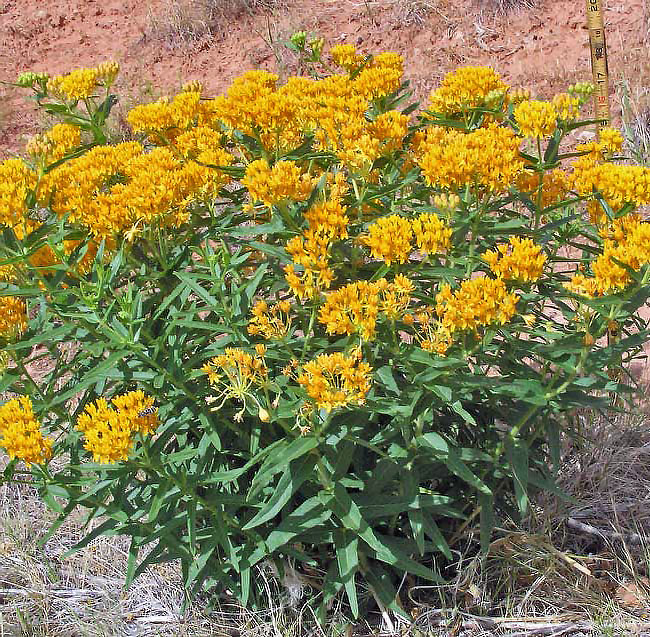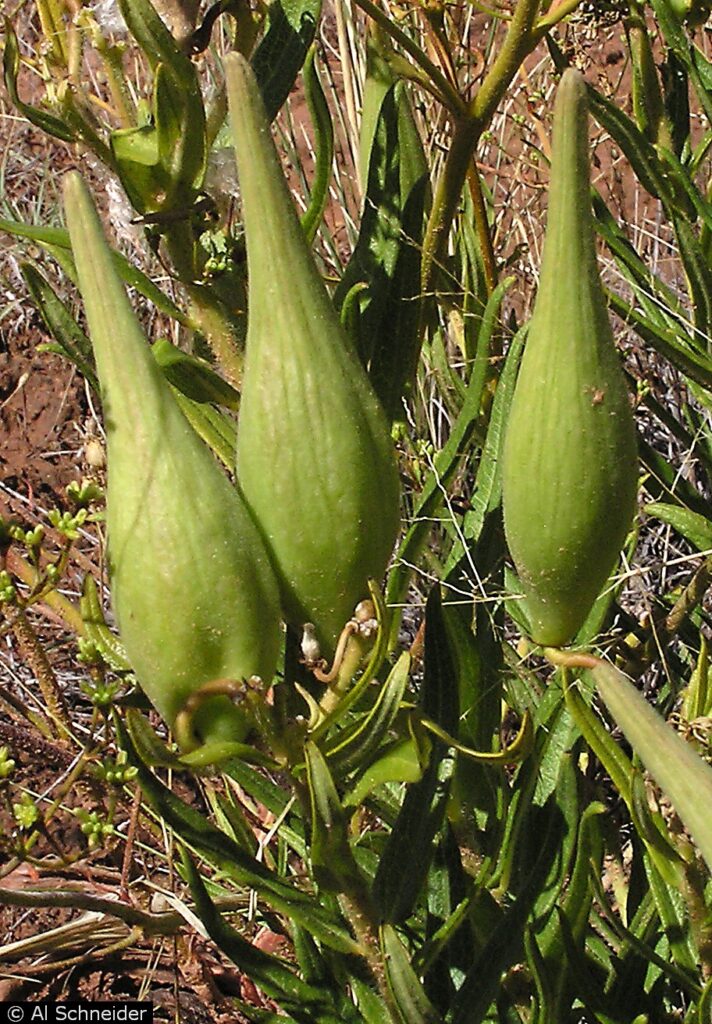Asclepias tuberosa
By Karen Vanderwall

Most gardeners and many lovers of the outdoors are familiar with milkweeds. Showy milkweed, our most common native here in Colorado, is tall with clusters of pink flowers. Or perhaps you’ve noticed the orange flowers of the less common more compact milkweed, the native butterfly weed, Asclepias tuberosa. Most milkweeds have white sap (the milk in milkweed), and large seed pods that open in the fall to release seeds with white whisps of silk that are swept by the wind.
But often, particularly in recent years, the first thing many nature and garden lovers alike first think of when they hear milkweed is how they support monarch butterflies. Monarchs have the longest migration of any butterfly in North America – up to 3,000 miles; a trip they make twice a year. Monarch populations have declined by as much as 80-90 percent over the past 30-40 years and are at risk for extinction. A huge factor for the decline is habitat loss. Because monarch caterpillars only eat milkweed plants, as native gardeners, creating habitat by planting milkweed is a no-brainer.
The relationship between milkweeds and monarch butterflies is fascinating. Milkweed plants have a white toxic sap contained in their tissues (leaves and stems). Even though butterfly weed does not have the white sap, its tissues are also toxic. The sap contains high concentrations of substances that are very toxic to most birds and animals. There are some insects, moths, butterflies and birds that can tolerate the toxicity. But because they don’t break down the substances, the monarchs, along with just a few other insects, can also store them in their tissues and use its toxicity as a defense mechanism against predators! Cool, right?

Ok, now back to more specific information about our Plant of the Month: butterfly weed, Asclepias tuberosa. Butterfly weed, also called butterfly milkweed, is a bushy, native perennial with beautiful clusters of bright orange flowers that bloom in mid-summer to early fall, and dark green lance shaped leaves. The narrow blue-green seed pods, or follicles, form in late summer and open in the fall to release numerous seeds that are attached to fluffy floss that help with wind dispersal. The species name, tuberosa, refers to its thick, tuberous roots. Here we need to emphasize that we are not talking about butterfly bush (Buddleja daviddii), which we highly discourage you from planting! Butterfly bush is invasive on the East Coast. It may not be so invasive here, but it is aggressive. Significantly, it is not a host plant for the larval caterpillar stage of butterflies, therefore not a good choice for our gardens. It is also not native to Colorado! (What it does have is a brilliant marketing name.)
Although the fact that the monarch caterpillar feeds exclusively on milkweed plants (butterfly weed included) is reason enough to grow them, there are many other pollinators that feed on them as well. A variety of bees, several species of moth, butterflies, skippers, flies, beetles and hummingbirds feed on the flower nectar and monarch butterflies rely on the nectar for energy for their long migration. Native milkweeds are utilized by birds in several ways. Some, like goldfinches and chickadees use their fluffy seeds for nest building and insulation. The insects that are attracted to flowers are eaten by insect-loving birds. And other insects feed on milkweed seed.
Butterfly weed is a nice addition to any native garden. It pairs well with other native perennials like Liatris, Rudbeckia, little bluestem or Coreopsis.

Along with its beautiful orange flowers and ecological significance, the butterfly weed is a perfect size for most gardeners. While species such as showy milkweed can reach heights of 5 feet, the butterfly weed is a smaller size of 1 to 2 ½ feet tall. Its size and compact habit may be a better fit for gardeners that prefer a smaller size milkweed or have less space. Also, it does not spread as readily as other more aggressive milkweeds that have rhizomes. Instead, it expands by growing multiple stems from its base. It simply gets bushier.
Asclepias tuberosa can be found at local nurseries (I bought two last year), and the numerous seeds can be collected in the fall for propagation. Butterfly weed needs a cold stratification period, so it is best to plant the seeds in the fall for germination in the spring. Because of its tuberous roots, they do not transplant well.
Butterfly weed prefers full sun and well-drained soil, either sandy or rocky. Once established, butterfly weed requires minimal maintenance and can tolerate dry conditions due to its tap root.
Plant butterfly milkweed for an attractive addition to your garden and to support the monarchs. You will be rewarded by all the pollinators that will visit this important wildflower!
Sources Consulted
Milkweeds: Fascinating Plants, Home to Colorful Insects; CSU Colorado State
Shared Skies: Monarchs and Migratory Birds; US Fish and Wildlife Service,
The Western Monarch Milkweed Mapper
Plant of the Week: U.S. Forest Service USDA
Colorado Arts and Sciences Magazine, University of Colorado
Spreading milkweed, not myths; US Fish and Wildlife Service
Save the monarch; U.S. Fish & Wildlife Service
Native Milkweeds; Xerces Society
Common Milkweed Insects Wisconsin Horticulture University of Wisconsin
Butterfly weed; Wisconsin Horticulture, University of WisconsinButterfly Weed; Jefferson County CSU Extension
Milkweed Pollination: A Series of Fortunate Events by The Prairie Ecologist Chris Helzer.
